Commercial Convection Oven Guide

Table of Contents
Essential convection ovens for restaurants and commercial kitchens
Commercial convection ovens are essential cooking equipment for restaurants, bakeries, and foodservice operations requiring efficient, consistent heat distribution for baking, roasting, and cooking. These powerful appliances use forced-air convection to circulate hot air evenly around food, reducing cooking times by up to 25% compared to conventional ovens while delivering uniform results. Available in various deck configurations, sizes, depths, power sources, and placements, convection ovens cater to operations ranging from small cafes to high-volume bakeries. Unlike commercial steamers (which focus on moist-heat cooking), convection ovens specialize in dry-heat baking and roasting applications.
Types of Commercial Convection Ovens
GoFoodservice categorizes convection ovens by deck configuration, size, depth, power source, and placement. Each variation serves specific operational needs, from compact countertop units to high-capacity floor models.
Deck Configuration: Single, Double, Triple, and Quadruple Deck
Deck configuration determines vertical capacity and throughput for different operation sizes.
Single Deck Convection Ovens
Single deck ovens provide essential convection cooking in a compact footprint, ideal for operations with moderate production needs.

- Best Uses: Small to medium restaurants, cafes, and bakeries; satellite kitchen operations; hotels and assisted living facilities.
- Capacities: 5-12 cubic feet; accommodates 3-5 full-size sheet pans.
- Features: Single chamber design, standard controls, efficient for batch cooking.
- Pros: More affordable, easier installation, suitable for limited space, simpler operation.
- Cons: Lower throughput than multi-deck models, may require multiple units for high volume.
Double Deck Convection Ovens
Double deck ovens stack two cooking chambers vertically, doubling capacity while maintaining a similar footprint to single deck models.

- Best Uses: High-volume restaurants, bakeries, and institutional kitchens; operations with consistent high production demands.
- Capacities: 10-24 cubic feet total (5-12 cu ft per chamber); accommodates 6-10 full-size sheet pans.
- Features: Two independent chambers, programmable controls, steam injection options, higher BTU output.
- Pros: Doubled capacity in same footprint, energy efficient per unit cooked, consistent results across both chambers.
- Cons: Higher initial cost, requires proper ventilation for upper chamber, more complex electrical requirements.
Triple Deck Convection Ovens
Triple deck ovens provide maximum vertical capacity for large-scale commercial baking operations, stacking three chambers for exceptional throughput.
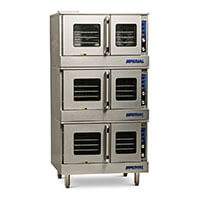
- Best Uses: Large bakeries, institutional kitchens, high-volume production facilities; operations requiring continuous large-batch baking.
- Capacities: 15-36 cubic feet total (5-12 cu ft per chamber); accommodates 9-15 full-size sheet pans.
- Features: Three independent chambers, advanced controls, superior insulation, optimized for continuous operation.
- Pros: Maximum capacity for high-volume baking, efficient space utilization, consistent performance across all chambers.
- Cons: Highest initial investment, complex installation and ventilation requirements, requires experienced operators.
Quadruple Deck Convection Ovens
Quadruple deck ovens represent the pinnacle of commercial convection baking capacity, stacking four chambers for unmatched production capabilities.
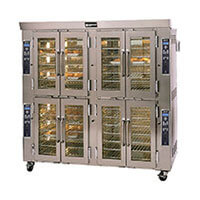
- Best Uses: Large-scale commercial bakeries, food production facilities, institutional operations; facilities with extreme production demands.
- Capacities: 20-48 cubic feet total (5-12 cu ft per chamber); accommodates 12-20 full-size sheet pans.
- Features: Four independent chambers, advanced automation, superior thermal efficiency, designed for heavy-duty continuous use.
- Pros: Ultimate production capacity, maximizes floor space efficiency, provides redundancy for continuous operation.
- Cons: Highest cost and complexity, requires specialized installation and maintenance, limited availability.
Size: Full, Half, and Quarter Size
Oven width determines the number of sheet pans that can be cooked simultaneously.
Full Size Convection Ovens (18-20 inches wide)
Full size ovens are the standard width for commercial sheet pans, accommodating the most common baking trays.
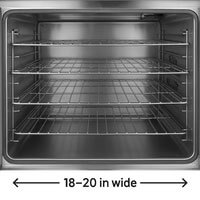
- Best Uses: Professional bakeries, large restaurants, and institutional kitchens with high-volume baking needs.
- Capacities: Standard full-size sheet pans (18x26 inches), 3-5 pans per deck depending on depth.
- Features: Compatible with industry-standard baking equipment, maximum capacity per run.
- Pros: Highest throughput, most versatile for various pan sizes, industry standard dimensions.
- Cons: Requires more floor space, higher energy consumption, not suitable for smaller operations.
Half Size Convection Ovens (13-15 inches wide)
Half size ovens accommodate half-size sheet pans, offering flexibility for smaller batch cooking or specialized operations.
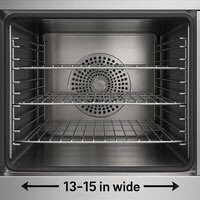
- Best Uses: Small restaurants, cafes, and specialty bakeries; operations needing flexibility with smaller batches.
- Capacities: Half-size sheet pans (13x18 inches), 2-3 pans per deck.
- Features: Compact width, suitable for smaller spaces, good for portion control and specialty items.
- Pros: Space-efficient, lower energy costs, ideal for smaller menus or limited production.
- Cons: Lower capacity per run, may require more frequent loading, less efficient for large batches.
Quarter Size Convection Ovens (9-10 inches wide)
Quarter size ovens are designed for countertop use and small-scale operations with minimal space and production needs.
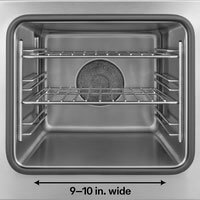
- Best Uses: Small cafes, quick-service operations, and satellite kitchens; countertop baking needs.
- Capacities: Quarter-size sheet pans (9x13 inches), 1-2 pans per deck.
- Features: Countertop design, 120V operation, simple controls, compact footprint.
- Pros: Most affordable, easiest installation, minimal space requirements, suitable for small operations.
- Cons: Very limited capacity, not practical for medium to large operations, frequent loading required.
Depth: Standard vs Bakery Depth
Oven depth affects the number of pans that can fit front-to-back and overall capacity.
Standard Depth Convection Ovens (24-28 inches deep)
Standard depth ovens accommodate 3-4 full-size sheet pans front-to-back, providing good capacity for most operations.

- Best Uses: General restaurant and bakery applications, operations with standard production needs.
- Capacities: 3-4 sheet pans deep, depending on rack spacing.
- Features: Balanced capacity and footprint, suitable for most commercial applications.
- Pros: Good balance of capacity and space efficiency, versatile for various menu items.
- Cons: Less capacity than bakery depth models for high-volume baking.
Bakery Depth Convection Ovens (32-36 inches deep)
Bakery depth ovens accommodate 4-5 full-size sheet pans front-to-back, maximizing capacity for high-volume baking operations.
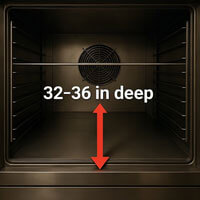
- Best Uses: Professional bakeries, large restaurants, and institutional kitchens with high-volume baking demands.
- Capacities: 4-5 sheet pans deep, significantly higher throughput per run.
- Features: Extended chamber depth, higher BTU ratings, designed for continuous high-volume production.
- Pros: Maximum capacity for baking operations, higher efficiency for large batches.
- Cons: Larger footprint, higher energy consumption, may be overkill for smaller operations.
Power Source: Electric vs Gas
Power source affects installation requirements, operating costs, and performance characteristics.
Electric Convection Ovens
Electric ovens use resistance heating elements and are preferred for their precise temperature control and ease of installation.
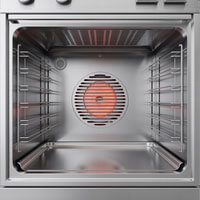
- Best Uses: Operations with existing electrical infrastructure, facilities requiring precise temperature control, indoor installations.
- Features: Even heat distribution, programmable controls, no gas lines required, consistent performance.
- Pros: Easier installation, precise temperature control, no ventilation concerns for gas byproducts, suitable for any location.
- Cons: Higher operating costs, may require upgraded electrical service, slower heat recovery than gas models.
Gas Convection Ovens
Gas ovens use natural gas or propane burners for fast, powerful heating suitable for high-volume operations.
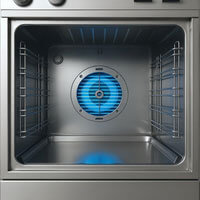
- Best Uses: High-volume restaurants and bakeries, operations requiring fast heat recovery, facilities with gas infrastructure.
- Features: Natural gas or propane operation, high BTU output, fast heat recovery, cost-effective for continuous use.
- Pros: Lower operating costs for high-volume use, faster heat recovery, reliable in continuous operation.
- Cons: Requires gas line installation, needs proper ventilation for combustion byproducts, may have temperature fluctuations.
Placement: Countertop vs Free Standing
Placement determines installation requirements and space utilization.
Countertop Convection Ovens
Countertop models sit on existing work surfaces, requiring no floor space but limited in capacity.
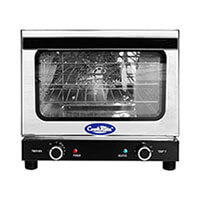
- Best Uses: Small cafes, quick-service operations, and satellite kitchens with limited space.
- Features: Compact design, 120V operation, simple installation, portable options available.
- Pros: No floor space required, affordable, easy to install and relocate.
- Cons: Limited capacity and power, not suitable for high-volume operations, may require more frequent loading.
Free Standing Convection Ovens
Free standing models are floor-mounted units with larger capacity and power options.
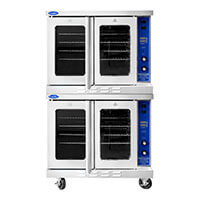
- Best Uses: Restaurants, bakeries, and institutional kitchens requiring substantial cooking capacity.
- Features: Floor-mounted design, higher power ratings, larger chambers, stackable options.
- Pros: Higher capacity and power, suitable for heavy commercial use, scalable with stacking.
- Cons: Requires floor space, higher installation costs, more complex electrical/gas requirements.
Convection Oven Configuration Comparison
| Configuration: | Deck Type: | Size: | Capacity: | Best For: | Price Range: |
| Single Deck | Single | Full Size | 5-12 cu ft | Medium restaurants | $3,000-8,000 |
| Double Deck | Double | Full Size | 10-24 cu ft | High-volume bakeries | $6,000-16,000 |
| Triple Deck | Triple | Full Size | 15-36 cu ft | Large bakeries | $9,000-22,000 |
| Quadruple Deck | Quadruple | Full Size | 20-48 cu ft | Production facilities | $12,000-30,000 |
| Countertop | Single | Quarter/Half | 0.8-3 cu ft | Small cafes | $1,500-4,000 |
| Bakery Depth | Single/Double | Full Size | 8-20 cu ft | Professional bakeries | $5,000-15,000 |
| Gas Powered | Single/Double | Full Size | 5-15 cu ft | High-volume operations | $4,000-14,000 |
| Electric Powered | Single/Double | Full Size | 5-15 cu ft | Precise control needed | $3,500-12,000 |
Note: Capacities and features vary by manufacturer and specific model; always verify electrical/gas requirements and dimensions for your specific needs.
Features & Accessories
Commercial convection ovens include essential features for optimal performance, safety, and ease of operation.
Key Features
Modern convection ovens incorporate advanced technology for consistent results and operational efficiency.
- Digital Controls: Touchscreen interfaces with programmable recipes, temperature probes, and time settings for precise cooking control.
- Air Distribution: Multiple fan configurations ensure even heat circulation; reversing fans prevent hot spots and improve consistency.
- Temperature Range: 150-500°F operating range; some models include steam injection for added moisture control.
- Interior Lighting: Halogen or LED lighting allows monitoring of cooking progress without opening doors.
- Self-Cleaning: Automated cleaning cycles with specialized detergents reduce maintenance time and labor.
Accessories
Supporting equipment enhances oven functionality and operational efficiency.
- Wire Racks & Pans: Heavy-duty stainless steel racks and sheet pans designed for convection cooking; various sizes available.
- Temperature Probes: Digital probes for monitoring internal food temperatures and preventing overcooking.
- Steam Pans & Trays: Specialized pans for combination ovens and retherm applications.
- Rack Guides: Adjustable rack positioning for different food heights and cooking requirements.
- Cleaning Supplies: NSF-approved cleaners and detergents specifically formulated for convection ovens.
Selecting Commercial Convection Ovens
Choosing the right convection oven requires careful consideration of operational needs, space constraints, and budget requirements.
Capacity & Production Volume
Match oven capacity to your daily production requirements to ensure efficient operation without bottlenecks.
Tip: Calculate capacity based on peak hours, aim for 20-30% extra capacity for busy periods and menu expansion.
- Low Volume (Cafes/Quick Service): Countertop models (0.8-1.5 cu ft); suitable for 50-200 meals per day.
- Medium Volume (Restaurants): Single full-size units (5-8 cu ft); appropriate for 200-500 meals per day.
- High Volume (Bakeries/Institutional): Double-deck or stacked units (10-25+ cu ft); necessary for 500+ meals per day.
- Ultra-High Volume (Production Facilities): Triple or quadruple-deck units (15-48+ cu ft); required for 1,000+ meals per day or large-scale baking operations.
Power Source & Energy Efficiency
Consider electrical requirements and operating costs when selecting power sources.
- Electric Models: Require 120-240V service; most common for flexibility and ease of installation.
- Gas Models: Natural gas or propane options; preferred for high-volume operations with existing gas lines.
- Energy Efficiency: Look for ENERGY STAR certification and features like insulated chambers and efficient fans.
Space & Installation Requirements
Ensure proper clearances and ventilation for safe, efficient operation.
- Clearances: Minimum 6 inches from combustible surfaces; allow space for door opening and servicing.
- Ventilation: Dedicated exhaust hood required for grease removal and heat dissipation.
- Electrical Service: Verify amperage requirements (30-60+ amps) and available circuits.
- Plumbing: Combination units require water line connection for steam generation.
Budget & Total Cost of Ownership
Factor in purchase price, installation, and operating costs over the equipment's lifespan.
- Purchase Price: $1,500-18,000 depending on type, capacity, and features.
- Installation Costs: $500-3,000 for electrical work, ventilation, and plumbing.
- Operating Costs: Electric models: $0.10-0.20/hour; Gas models: $0.05-0.15/hour depending on usage.
- Maintenance: Annual service contracts recommended; parts availability important for longevity.
Safety & Compliance
Prioritize equipment meeting health, safety, and building code requirements.
- NSF Certification: Required for commercial food equipment; ensures sanitary design and construction.
- UL/CSA Listing: Verifies electrical and gas safety compliance.
- Ventilation Requirements: Must meet local fire and building codes for grease exhaust.
- Operator Training: Ensure staff training for safe operation and maintenance procedures.
Quick Selection Checklist:
- Daily production volume and menu requirements?
- Available space and electrical service?
- Budget for purchase and installation?
- Required cooking methods (baking, roasting, steaming)?
- Ventilation and safety compliance needs?
Installation & Maintenance
Proper installation and maintenance ensure optimal performance and longevity of convection ovens.
Installation Requirements
Professional installation prevents safety issues and ensures proper operation.
- Electrical: Dedicated circuit with correct voltage and amperage; ground fault protection required.
- Gas (if applicable): Certified gas technician for line connections; proper ventilation mandatory.
- Ventilation: Commercial exhaust hood with grease filters; make-up air may be required.
- Clearances: Minimum 6 inches from walls and ceilings; allow access for servicing.
- Leveling: Units must be level for proper drainage and even cooking.
Maintenance Schedule
| Task | Frequency | Description |
| Clean interior | Daily | Remove racks and clean chamber with approved cleaners |
| Clean exterior | Weekly | Wipe down control panel and stainless steel surfaces |
| Inspect door seals | Weekly | Check for cracks or wear; replace if damaged |
| Clean ventilation | Monthly | Remove and clean grease filters; check ductwork |
| Calibrate temperature | Quarterly | Verify thermostat accuracy with independent thermometer |
| Deep clean cycle | Monthly | Run automated cleaning cycle with proper chemicals |
| Professional service | Annually | Complete inspection by certified technician |
Common Issues & Troubleshooting
Address problems promptly to maintain consistent performance.
- Uneven Cooking: Check fan operation and rack positioning; ensure proper loading.
- Temperature Inaccuracy: Calibrate controls or replace faulty sensors.
- Excessive Noise: Clean fan blades; check for obstructions or bearing wear.
- Door Seal Problems: Replace worn gaskets to maintain temperature and efficiency.
Costs & ROI Considerations
Understanding the financial aspects helps justify convection oven investments.
Initial Investment
- Countertop Models: $1,500-4,000
- Single Full-Size: $4,000-8,000
- Double-Stack Units: $8,000-16,000
- Triple Deck Units: $12,000-24,000
- Quadruple Deck Units: $16,000-32,000
- Combination Ovens: $8,000-18,000
Operating Costs
- Energy: Electric: $0.10-0.20/hour; Gas: $0.05-0.15/hour
- Maintenance: $200-500 annually for service contracts
- Cleaning Supplies: $50-100 monthly
Return on Investment
- Time Savings: 25-30% faster cooking reduces labor costs
- Energy Efficiency: Better heat utilization compared to conventional ovens
- Product Quality: Consistent results reduce waste and customer complaints
- Capacity Increase: Higher throughput supports business growth
ROI Timeline: Most operations see payback within 18-24 months through labor savings and increased capacity.
Frequently Asked Questions
What's the difference between convection and conventional ovens?
Convection ovens use fans to circulate hot air, cooking 25-30% faster with more even results. Conventional ovens rely on natural convection and radiant heat, requiring longer cook times and more attention to rotation.
How much space do I need for a commercial convection oven?
Full-size models need 30-40 square feet including clearances. Countertop models require 2-3 square feet of counter space. Always allow 6 inches clearance on all sides for safety and ventilation.
Do convection ovens require special ventilation?
Yes, all commercial convection ovens need proper exhaust hoods to remove grease-laden vapors and heat. Local codes may require dedicated make-up air systems. Countertop models in small spaces may need enhanced ventilation.
Can I cook everything in a convection oven?
Convection ovens excel at baking, roasting, and reheating but may require recipe adjustments for delicate items. They're not ideal for broiling fatty meats due to grease splatter. Combination models handle steaming tasks as well.
What's the maintenance like for convection ovens?
Daily cleaning of the interior and racks is essential. Weekly exterior cleaning and monthly deep cleaning cycles prevent buildup. Annual professional servicing ensures continued performance and safety.
Are convection ovens energy efficient?
Yes, they use energy more efficiently than conventional ovens due to faster cooking times and better heat distribution. ENERGY STAR certified models offer additional savings through improved insulation and controls.
How long do commercial convection ovens last?
With proper maintenance, quality convection ovens last 10-15 years. Regular cleaning and professional servicing extend lifespan. Stainless steel construction resists corrosion in commercial environments.
Can convection ovens be stacked?
Many models are designed for stacking (2-3 units high) to maximize space efficiency. Requires proper ventilation and electrical capacity. Some manufacturers offer stacking kits for safe, stable configurations.
What's the difference between electric and gas convection ovens?
Electric models are easier to install and offer precise temperature control. Gas models provide faster heat recovery and are preferred for high-volume operations with existing gas infrastructure. Electric is more common in smaller establishments.
Do convection ovens require water connections?
Standard convection ovens don't need water. Combination steam/convection models require cold water and drain connections. Retherm models may need water for humidity control.
Related Equipment
Complete your cooking setup with these complementary commercial kitchen appliances.
- Convection Oven Accessories - Racks, pans, and maintenance supplies for optimal oven performance.
- Commercial Steamers - Separate moist-heat cooking equipment for vegetables, proteins, and rice.
- Commercial Ranges - Traditional cooking equipment for versatile meal preparation.
- Commercial Microwaves - Quick heating and reheating solutions.
- Commercial Refrigerators & Freezers - Essential food storage and preparation equipment.
- Commercial Dishwashers - High-volume cleaning for pots, pans, and dishware.
Need help selecting the right commercial convection oven? Contact our foodservice specialists for personalized recommendations based on your menu, volume, and space requirements.
Share This!